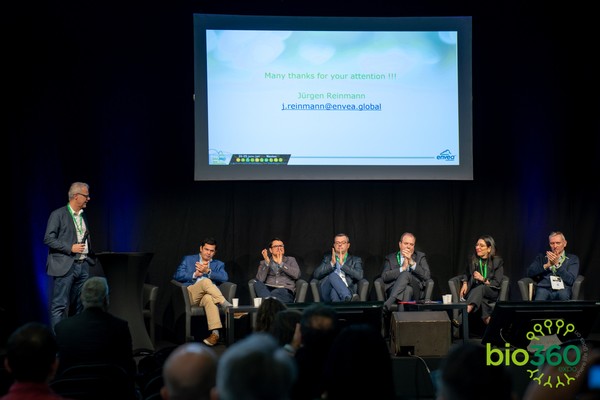CONFERENCE: “Decarbonising the Future: Waste-to-Energy’s Vital Role as Part of the BIO-ecosystem”

What is the role of Waste-to-Energy in reaching Europe’s CO2 emissions reduction and removal targets? This pivotal question was at the center of the debate at the conference “Decarbonising the Future: Waste-to-Energy’s Vital Role as Part of the BIO-ecosystem”, organised by ESWET – The European Suppliers of Waste-to-Energy Technology on 25 January at BIO360 Expo in Nantes.
The conference saw the intervention of international speakers from the industrial sector, international think tanks, and European associations who enriched the session with their insightful inputs.
Antonella Del Figliolo, Policy Officer at ESWET, highlighted the advantages that the Waste-to-Energy (WtE) sector and its technologies are bringing to the green transition, where we are in terms of technology deployment, and what we need to focus on in the upcoming years if we want to achieve the EU climate goals.

Dominic Rassool, Senior Client Engagement Lead Europe at the Global CCS Institute, presented on how to enable and accelerate the CCS deployment for a net-zero emissions future. Mr. Rassool briefed the audience about the barriers to the deployment of CCS, pointing out that while some risks can be reduced through the actual deployment; others, such as cross-chain or long-term storage liability, require the direct intervention of Governments. Certainly, there are positive signals across the globe, however, the role of CCS and Carbon Dioxide Removals (CDR) must be better defined, the identification and appraisal of geological storage resources must be supported and specific CCS laws and regulations must be developed.
Alain Bill, Member of the ESWET Technical Committee and CCUS Working Group, Vice President of the Global Sales and Business Development – Air Pollution Control Division at ANDRITZ, and David Boyer, Member of the ESWET Technical Committee, and Sales Director at LAB both gave the audience a more industrial-oriented overview of the integration of CCUS into WtE plants. Mr. Bill presented the ANDRITZ concepts for CCUS-ready WtE plants, highlighting the evaluation framework, the boundaries and conditions that define the selection of the CO2 capture solution as well as the solutions offered by the company for the decarbonization of WtE plants. Mr. Boyer, instead, delivered a presentation on how to maximise heat recovery in WtE plants and synergies with Carbon Capture for decarbonisation. After a brief overview of what LAB does and some of the projects that the company has been working on in Europe, Mr. Boyer shared his knowledge of Flue Gas Treatment and CCS and how the synergies between these two technologies can speed the decarbonisation road. In his conclusion, he highlighted that Carbon Capture in a WtE plant is feasible and already ongoing.
Fabio Poretti, Scientific and Technical Officer at CEWEP – The Confederation of European Waste-to-Energy Plants, drove the audience into the WtE Operators world stating since the very beginning of his speech why and how circular economy and climate mitigation go hand in hand with WtE. The integration of CCUS technology into WtE can help the sector to become even carbon-negative in the future and WtE operators in Europe are looking at both CCS and CCU technology. After showcasing some successful stories among the different CCUS projects in WtE that have kicked off across Europe, Mr. Poretti concluded his presentation with an overview of relevant ongoing EU policies for CCUS.
The last two presentations of the Conference put under the spotlight another pressing topic pertaining to the WtE sector and its efforts to reduce emissions: how to measure, and therefore quantify and qualify, biogenic CO2 emissions from Waste-to-Energy Plants.
Jürgen Reinmann, Member of the ESWET Technical Committee, and Managing Director at ENVEA, presented the topic of “measuring biogenic CO2 emissions from Waste-to-Energy plants: success stories and challenges ahead”. Just after shortly introducing the audience to the world of the EU ETS, Mr. Reinmann explained that Municipal Solid Waste (MSW) and Refuse-derived fuel (RDF) processed from MSW and/or hazardous waste have unknown mixtures of biogenic and fossil organic matter; especially for those sectors falling under the scope of the ETS, it is important to determine the biogenic and fossil fraction. He concluded by highlighting how the implementation of the ETS already on municipal waste incinerators in several countries will help to collect information and experiences for the assessment of the European Commission in 2026 for a possible EU-wide extension of the ETS to WtE.

Olivier Bobin, CEO at CIRAM Lab, had the honor to close the conference with his presentation on “biogenic carbon content and origin by radiocarbon and isotopic techniques” The presentation focused on the analysis of the feedstock of Waste-to-Energy plants and of Solid Recovered Fuel (SRF), as well as on their CO2 emissions and on how to quantify and qualify the biogenic part of them. Dr. Bobin explained that radiocarbon analysis is the most reliable, fast, and accurate analysis to quantify the biobased content of SRFs, Solvents, and CO2 emissions.
On the side of the Conference, ESWET also organised the ESWET Pavilion along with 4 members – ANDRITZ, ENVEA Global, LAB, and Steinmüller Engineering GmbH.
Being at BIO360 Expo was an amazing opportunity for ESWET to place itself at the forefront of this growing industry and to show potential members all the benefits of joining the ESWET family, while advocating the vital role of the Waste-to-Energy sector in driving the transition to a more circular economy and paving the path to a sustainable future.